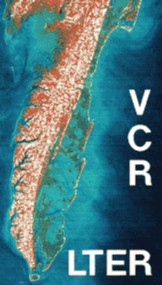 Using GPS Survey to Track the Evolution of Barrier Island Landforms |

R. Craig Kochel and C. Randy Carlson
Department of Geology and Department of Environmental Sciences
|
 Using GPS Survey to Track the Evolution of Barrier Island Landforms |

R. Craig Kochel and C. Randy Carlson
Department of Geology and Department of Environmental Sciences
|
Monitoring geomorphic changes in barrier island landforms at the scale necessary to detect annual changes important to understanding landform evolution and its relationship to vegetation dynamics is difficult at best using standard topographic surveying techniques. Problems using standard techniques such as laser total station surveying include: a) establishment of a large number of permnanent markers for site reoccupation, b) sand and salt-spray erosion of the optical instruments, and c) the time necessary to effect surveys of island topography where hundreds of points are required. Modern Global Positioning Survey (GPS) systems permit cm-scale resolution, upon post-processing, surveying of island landforms with significantly less time. Two GPS receivers are used in topographic mapping. The main station is deployed over a previously established benchmark of know coodinates on the site. The other unit is used as a 'roaming' unit to collect position fixes on sites of topographic interest around the site. Typically, more than 400 points can be surveyed in an 8-hour field day, and if necessary, using only one surveyor. The advantages of the GPS method include speed, accuracy, and a major decrease in the manpower requirements for topographic surveying.
Currently, we are experimenting with the technique to determine the limits of resolution for GPS and its effectiveness in documenting small-scale changes in washover fan sites, on dunes, and on chagnes to the shoreline from significant coastal storms. If successful, the time investied in surveying our long-term overwash monitoring sites will result in greatly expanded three-dimensional tracking of landform change. This information on landform change will not only expand our ability to document landform response to overwash but will also greatly improve our ability to monitor changes in island vegetation and hydrology at these sites. This information will greatly enhance our modeling efforts aimed at predicting island response to overwash stress over time.
We are also using this technique to investigate geomorphic and vegetative changes on an island-wide scale this year by using Myrtle Island as a study site. Myrtle Island experienced major erosion of high dune environments and washover fans alike during between a major GPS survey of the island by Carlson in Fall 1996 and April 1997. This inforamtion is being used to compliment to establish the topographic base for the emplacement of data on deoth to water table, groundwater salinity, and vegetation type and density.